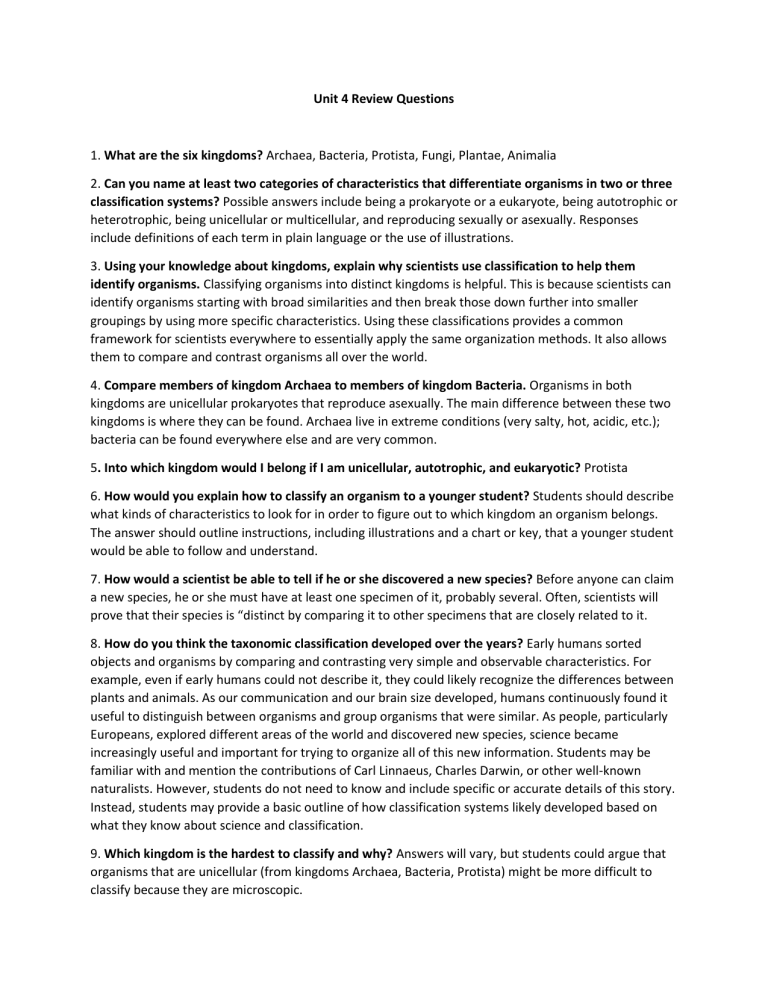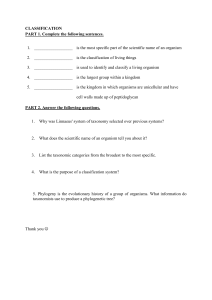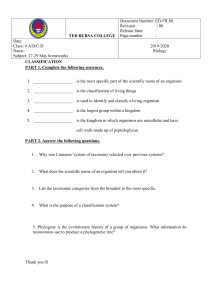
Unit 4 Review Questions 1. What are the six kingdoms? Archaea, Bacteria, Protista, Fungi, Plantae, Animalia 2. Can you name at least two categories of characteristics that differentiate organisms in two or three classification systems? Possible answers include being a prokaryote or a eukaryote, being autotrophic or heterotrophic, being unicellular or multicellular, and reproducing sexually or asexually. Responses include definitions of each term in plain language or the use of illustrations. 3. Using your knowledge about kingdoms, explain why scientists use classification to help them identify organisms. Classifying organisms into distinct kingdoms is helpful. This is because scientists can identify organisms starting with broad similarities and then break those down further into smaller groupings by using more specific characteristics. Using these classifications provides a common framework for scientists everywhere to essentially apply the same organization methods. It also allows them to compare and contrast organisms all over the world. 4. Compare members of kingdom Archaea to members of kingdom Bacteria. Organisms in both kingdoms are unicellular prokaryotes that reproduce asexually. The main difference between these two kingdoms is where they can be found. Archaea live in extreme conditions (very salty, hot, acidic, etc.); bacteria can be found everywhere else and are very common. 5. Into which kingdom would I belong if I am unicellular, autotrophic, and eukaryotic? Protista 6. How would you explain how to classify an organism to a younger student? Students should describe what kinds of characteristics to look for in order to figure out to which kingdom an organism belongs. The answer should outline instructions, including illustrations and a chart or key, that a younger student would be able to follow and understand. 7. How would a scientist be able to tell if he or she discovered a new species? Before anyone can claim a new species, he or she must have at least one specimen of it, probably several. Often, scientists will prove that their species is “distinct by comparing it to other specimens that are closely related to it. 8. How do you think the taxonomic classification developed over the years? Early humans sorted objects and organisms by comparing and contrasting very simple and observable characteristics. For example, even if early humans could not describe it, they could likely recognize the differences between plants and animals. As our communication and our brain size developed, humans continuously found it useful to distinguish between organisms and group organisms that were similar. As people, particularly Europeans, explored different areas of the world and discovered new species, science became increasingly useful and important for trying to organize all of this new information. Students may be familiar with and mention the contributions of Carl Linnaeus, Charles Darwin, or other well-known naturalists. However, students do not need to know and include specific or accurate details of this story. Instead, students may provide a basic outline of how classification systems likely developed based on what they know about science and classification. 9. Which kingdom is the hardest to classify and why? Answers will vary, but students could argue that organisms that are unicellular (from kingdoms Archaea, Bacteria, Protista) might be more difficult to classify because they are microscopic. 10. Is it more logical to classify an organism found in the Amazon jungle in kingdom Bacteria or kingdom Plantae? Students should describe how they would study the organism’s characteristics, looking at whether it was actually composed of one or multiple cells, whether it had the characteristics of a prokaryote or eukaryote, and whether it was heterotrophic or autotrophic. Students should explain that they can use a microscope and observe or test the organism’s behavior, including its mode of reproduction, in order to provide evidence to either support or refute the classification claims.





